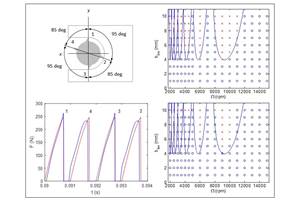A Subscription To Spindle Speeds
A peculiar characteristic of machine tools is that they can't be put to use until the user performs a critical final assembly step-installing the cutting tool in the machine.
Share







ECi Software Solutions, Inc.
Featured Content
View More

A peculiar characteristic of machine tools is that they can’t be put to use until the user performs a critical final assembly step—installing the cutting tool in the machine.
In fact, a machine tool user is typically required to make vital engineering decisions that affect how the machine performs. The user chooses what tooling the machine will use and the parameters at which those tools will run. Poor choices are difficult to detect, because the machine may still make the part—just less efficiently than it otherwise could.
Seeing the machine and tooling truly working in harmony has helped many shops realize the importance of viewing these elements as one system. Specifically, shops milling at higher spindle speeds often discover the phenomenon of the “sweet spot”—the particular, narrow range of spindle speed at which chatter quiets down to let the machine cut more productively. Because these sweet-spot speeds are different for each combination of tool and machine, neither the cutting tool supplier nor the machine tool supplier is typically able to suggest to shops what their optimal parameters should be.
Now, cutting tool supplier Kennametal has introduced a service that aims to provide this information. The service relies on technology from BlueSwarf, a company in Clearfield, Pennsylvania, that specializes in analyzing machine tool vibration. Called “Kennametal 360,” this new service allows clients to obtain machining parameters based on the “frequency response” signatures of specific machines. With BlueSwarf technology, Kennametal combines models of the machine, toolholder and cutting tool to predict the very best spindle speed for that particular combination, as well as the depths of cut that the combination can achieve in the material the shop is machining. Users of the service even get an ID number that lets them input the data online to obtain these parameters themselves.
Obtaining these sweet-spot parameters represents just part of the service, however, and arguably it represents just a small part. In total, the “360” service represents the cutting tool supplier taking accountability for those engineering decisions that lead to tooling-related choices, as well as the physical assembly of the tooling. According to Tim Fara, Kennametal’s global market segment manager for the machine tool industry, a user of this service can avoid having to devote a staff member to serve as a tool-crib attendant.
Subscribers to the service receive cutting tools and toolholders as complete, custom assemblies. These assemblies are balanced to G 2.0 where applicable, and all presetting measurements are included in the package. Optimal machining parameters for the user’s specific machines are provided via BlueSwarf, and the package even includes certified retention knobs. The user simply opens the package and puts the tooling to work.
Initially, a new user of this service gets a visit from a Kennametal representative. Studying the shop’s machines and parts allows that representative to recommend tooling. Generally, this visit is also when the frequency response characteristics of the user’s machines are captured. A “tap test” (in which a sensitive hammer rings the machine like a bell) obtains this information. However, when a shop changes its machine tools, it doesn’t have to wait for a return visit. A PC-interfaced microphone recording the sound of the cut can capture enough data to let Kennametal perform the frequency-response analysis of a new machine remotely. Or, the company might already have access to the information, because BlueSwarf has received permission from various machine tool builders to tap-test their machines. The company has the signatures of more than 100 machining center models already in its database.
An additional partner to this service is the American Machine Tool Distributors Association. An AMTDA member can sell the program card that provides access to the Kennametal 360 service as part of a single purchase price for a new machine tool. This arrangement allows the machine, the tooling and the engineering decisions that marry them together to be provided as a single system after all.
Related Content
The Impact of Cutting Teeth Spacing on Machining Stability
Many cutter designs are available, and variable teeth spacing (or variable pitch) cutters can be used to influence milling stability. Let’s discuss why teeth spacing affects stability.
Read MoreCustom PCD Tools Extend Shop’s Tool Life Upward of Ten Times
Adopting PCD tooling has extended FT Precision’s tool life from days to months — and the test drill is still going strong.
Read MoreQuick-Change Tool Heads Reduce Setup on Swiss-Type Turning Centers
This new quick-change tooling system enables shops to get more production from their Swiss turning centers through reduced tool setup time and matches the performance of a solid tool.
Read MoreHow to Accelerate Robotic Deburring & Automated Material Removal
Pairing automation with air-driven motors that push cutting tool speeds up to 65,000 RPM with no duty cycle can dramatically improve throughput and improve finishing.
Read MoreRead Next
Registration Now Open for the Precision Machining Technology Show (PMTS) 2025
The precision machining industry’s premier event returns to Cleveland, OH, April 1-3.
Read MoreBuilding Out a Foundation for Student Machinists
Autodesk and Haas have teamed up to produce an introductory course for students that covers the basics of CAD, CAM and CNC while providing them with a portfolio part.
Read More5 Rules of Thumb for Buying CNC Machine Tools
Use these tips to carefully plan your machine tool purchases and to avoid regretting your decision later.
Read More




































.jpg;maxWidth=300;quality=90)







